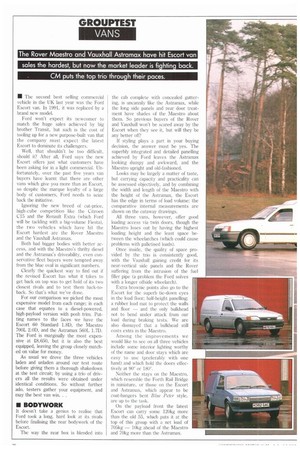GROUPTEST VANS
Page 30

If you've noticed an error in this article please click here to report it so we can fix it.
• The second best selling commercial vehicle in the UK last year was the Ford Escort van. In 1991, it was replaced by a brand new model.
Ford won't expect its newcomer to match the huge sales achieved by big brother Transit, but such is the cost of tooling up for a new purpose-built van that the company must expect the latest Escort to dominate its challengers.
Well, that shouldn't be too difficult, should it? After all, Ford says the new Escort offers just what customers have been asking for in a light commercial. Unfortunately, over the past five years van buyers have learnt that there are other vans which give you more than an Escort, so despite the marque loyalty of a large body of customers, Ford needs to seize back the initiative.
Ignoring the new breed of cut-price, high-cube competition like the Citroen C15 and the Renault Extra (which Ford will be tackling with a big-volume Fiesta), the two vehicles which have hit the Escort hardest are the Rover Maestro and the Vauxhall Astramax.
Both had bigger bodies with better access, and with the Maestro's thrifty diesel and the Astrarnax's driveability, even conservative fleet buyers were tempted away from the blue oval in significant numbers.
Clearly the quickest way to find out if the revised Escort has what it takes to get back on top was to get hold of its two closest rivals and to test them back-toback. So that's what we've done.
For our comparison we picked the most expensive model from each range; in each case that equates to a diesel-powered, high-payload version with posh trim. Putting names to the faces we have the Escort 60 Standard 1.8D, the Maestro 700L 2.0D, and the Astramax 560L 1.7D. 'Ile Ford is marginally the most expensive at £8,650, but it is also the best equipped, leaving the group closely matched on value for money.
As usual we drove the three vehicles laden and unladen around our test route before giving them a thorough shakedown at the test circuit; by using a trio of drivers all the results were obtained under identical conditions. So without further ado, testers gather your equipment, and may the best van win. . .
It doesn't take a genius to realise that Ford took a long, hard look at its rivals before finalising the rear bodywork of the Escort.
The way the rear box is blended into
the cab complete with concealed guttering, is uncannily like the Astramax, while the long side panels and rear door treatment have shades of the Maestro about them. So previous buyers of the Rover and Vauxhall won't be scared away by the Escort when they see it, but will they he any better off?
If styling plays a part in your buying decision, the answer must be yes. The superbly integrated and detailed panelling achieved by Ford leaves the Astramax looking dumpy and awkward, and the Maestro upright and old-fashioned.
Looks may be largely a matter of taste, but carrying capacity and practicality can be assessed objectively, and by combining the width and length of the Maestro with the height of the Astramax, the Escort has the edge in terms of load volume: the comparative internal measurements are shown on the cutaway drawings.
All three vans, however, offer good loading access via twin doors, though the Maestro loses out by having the highest loading height and the least space between the wheelarches (which could cause problems with palletised loads).
Once inside, the quality of space provided by the trio is consistently good, with the Vauxhall gaining credit for its near-vertical side panels and the Rover suffering from the intrusion of the fuel filler pipe (a problem the Ford solves with a longer offside wheelarch).
Extra brownie points also go to the Escort for the superb tie-down eyes in the load floor; half-height panelling; a rubber load mat to protect the walls and floor — and the only bulkhead not to bend under attack from our load during braking tests. We are also dismayed that a bulkhead still costs extra in the Maestro.
Among the improvements we would like to see on all three vehicles include some interior lighting worthy of the name and door stays which are easy to use (preferably with one hand) and which hold the doors effectively at 900 or Neither the stays on the Maestro, which resemble the Forth Rail Bridge in miniature, or those on the Escort and Astramax, which appear to be coat-hangers bent Blue Peter style, are up to the task.
On the payload front the latest Escort can carry some 120kg more than the old 55, which puts it at the top of this group with a net load of 705kg — 10kg ahead of the Maestro and 70kg more than the Astramax.
















































































